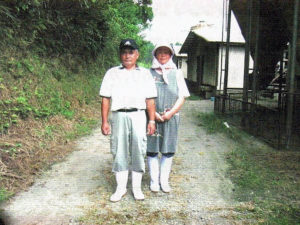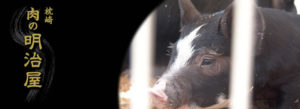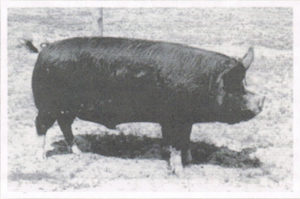What is “Black Pig” (Kagobuta)?english
Originating from the southernmost area of Kagoshima prefecture, Makurazaki’s ‘Black Pig’.

「Kayano pig farm」 -
Located in Kagoshima prefectures’s southernmost area, Makurazaki city is located by the East China Seas. Established since the olden days, the city has a thriving fisheries industry and is Japan’s top producer of skipjack tuna. The city is also known throughout Japan for it’s spirits, and is the birth place of Satsumi Shironami Shochu.
It is here in the subtropical climate of Makurazaki that Kagoshima’s famous sweet potatoes and other grain are grown, and have inspired the creations of the high quality meats that are Makurazaki’s Kurobuta (‘Black Pig’) also known as Kagobuta.
Furthermore, our Kagobuta is obtained from the exclusive Kayano group which is apart of the Kagoshima Prefecture Black Pig Producers Association, and provides only the safest and most delicious black pigs there are.
How Makurazaki’s Black Pig became the brand known as “Kagobuta”.

-
In 1949 Makurazaki began shipping live, Makurazaki grown, Black Pigs to Tyoko from Makurazaki’s Kago station. It was during this time that the meat of the pigs became known for their delicious taste and quality. In those days freighters, trucks and most cargo were labeled by their ports of origin, in this case Kago Station. As a result, when the pigs were delivered to markets and restaurants they became known as Kago Buta, Kago; for their station of origin and Buta; the Japanese word for pig. This is how the country’s first pig brand Kagobuta was born.
What makes a black pig, “Kagobuta”?

-
In order to be label Kagobuta, pigs must be purebred Berkshire and bred in captivity. Their feed must consist of 10 ~ 20% sweet potatoes and must be raised for minimum of 230 days and a maximum of 370 days.
Furthermore, the health and growth of the pigs must be measured and recorded. The proper feeding methods, sweet potato blends and percentage must be observed and other unique and technical know-how is required for their raising.
The secret to what makes Kagobuta so delicious?
Kagobuta‘s meat fibers are fine, which lend to a delicate and tender meat texture. Kagobuta is low in fat and cholesterol, has 10 times more vitamin B1 than that of beef or chicken and contains an abundance essential amino acids. Kagobuta‘s fatty sections have a decent amount of fat which share the same texture comparable to the meat itself.





